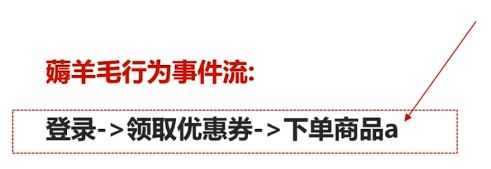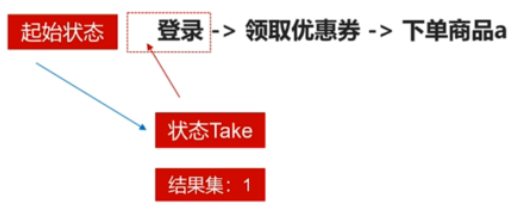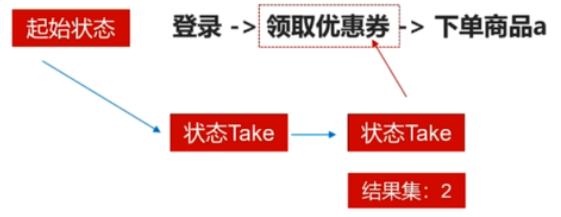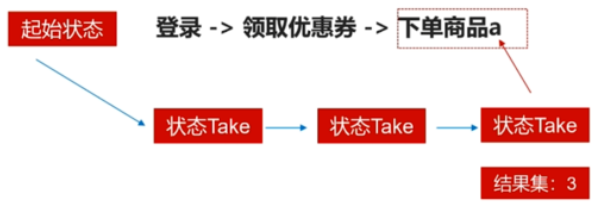【高级应用】Flink Cep模式匹配
什么是Cep?
在流式数据中(事件流),筛选出符合条件的一系列动作(事件)【复杂事件处理】
什么是 Flink-Cep?
Flink Cep库Api 【实时操作】
什么是Pattern?
Pattern就是Cep里的规则制定
Pattern分为个体模式,组合模式(模式序列)和模式组
模式组是将组合模式作为条件的个体模式
Cep开发流程
- DataStream 或
Keyedstream - 定义
规则(Pattern) - 将
规则应用于KeyedStream,生成PatternStream - 将
PatternStream,通过Select方法,将符合规则的数据输出
代码实战
依赖
<!-- Flink-Cep -->
<dependency>
<groupId>org.apache.flink</groupId>
<artifactId>flink-cep_${scala.binary.version}</artifactId>
<version>${flink.version}</version>
</dependency>

Cep开发伪代码(个体模式和组合模式)
public class CepDemo {
public static void main(String[] args) {
// 创建流式计算上下文环境
StreamExecutionEnvironment env = StreamExecutionEnvironment.getExecutionEnvironment();
// 生成DataStream
DataStream<String> dataStream = null;
// 生成KeyedStream (分组)
KeyedStream<String, Tuple> keyedStream = dataStream.keyBy("");
// 生成模式(规则) ( Pattern 对象)
/* **********************
*
* 【个体模式】
* 1. 【单例】模式:只接收1个事件
* 2. 【循环】模式:能接收多个事件或1个事件, 单例模式 + 量词(times())
* *********************/
// 生成名叫 “login” 的单个Pattern
Pattern<String, String> pattern =
Pattern.<String>begin("login").where(new SimpleCondition<String>() {
@Override
public boolean filter(String s) throws Exception {
// Patter规则内容
return false;
}
}).times(3);
/* **********************
* 【组合模式】
*
* 组合方式:
* 1. next: 严格紧邻 (连续)
* 2. fallowedBy: 宽松近邻 (非连续)
* 3. fallowedByAny: 非严格匹配,比 fallowedBy 更宽松
*
* *********************/
// 生成了两个Patten所组成的Pattern序列,分别名叫 "login", "sale"
Pattern<String, String> patterns =
Pattern.<String>begin("login")//.where()
.followedBy("sale");//.where();
// 将 Pattern 应用于 KeyedStream, 生成 PatternStream 对象
PatternStream<String> patternStream = CEP.pattern(keyedStream, patterns);
// 通过PatternStream 对象的 select() 方法, 将符合规则的数据提取输出
DataStream<Object> patternResult = patternStream.select(new PatternSelectFunction<String, Object>() {
/**
* @param map: key: 指的是Pattern的名称。 value: 符合这个Pattern的数据
*/
@Override
public Object select(Map<String, List<String>> map) throws Exception {
return null;
}
});
}
}
【生成模式】
基于【个体模式】检测最近1分钟内登录失败超过3次的用户
CEP模式:允许这3次登录失败事件之间出现其他行为事件(不连续)【宽松近邻】
public class LoginFailBySingleton {
public static void main(String[] args) {
// Kafka数据源
DataStream<EventPO> eventStream = KafkaUtil.read(args);
// 生成KeyedStream 用户id分组
KeyedStream<EventPO, Integer> keyedStream = eventStream.keyBy((KeySelector<EventPO, Integer>) EventPO::getUser_id_int);
// 生成模式 (规则/Pattern)
Pattern.
<EventPO>begin("login_fail_first") // Pattern名称
/*
1. IterativeCondition 抽象类 表示通用的匹配规则
需要实现 filter(), 需要传入2个参数
2.SimpleCondition 是 IterativeCondition 的子类,表示简单的匹配规则
需要实现 filter(), 需要传入1个参数
*/
.where(new SimpleCondition<EventPO>() {
@Override
public boolean filter(EventPO eventPO) {
// 登录失败事件
return EventConstant.LOGIN_FAIL.equals(eventPO.getEvent_name());
}
})
.times(3) // 3次,宽松近邻
.within(Time.seconds(60)); // 最近一分钟(时间)
}
}
检测最近1分钟内【连续】登录失败超过3次的用户
基于【个体模式】
CEP模式:3次登录失败事件必须是连续的【严格紧邻】
添加该方法即可
.consecutive()
public class LoginFailByConsecutive {
public static void main(String[] args) {
// Kafka
DataStream<EventPO> eventStream = KafkaUtil.read(args);
// 生成KeyedStream
KeyedStream<EventPO, Integer> keyedStream = eventStream.keyBy(new KeySelector<EventPO, Integer>() {
@Override
public Integer getKey(EventPO eventPO) throws Exception {
return eventPO.getUser_id_int();
}
});
Pattern.
<EventPO>begin("login_fail_first")
.where(new SimpleCondition<EventPO>() {
@Override
public boolean filter(EventPO eventPO) throws Exception {
return EventConstant.LOGIN_FAIL.equals(eventPO.getEvent_name());
}
})
/* **********************
* 1. 个体模式的循环模式 匹配的是 宽松近邻 (能够允许插入其他事件)
* 2. consecutive() 就指定匹配模式是 严格紧邻(连续)
* *********************/
.times(3)
.consecutive() // 连续
.within(Time.seconds(60));
}
}
宽松近邻与严格紧邻
宽松近邻:不连续事件
严格紧邻:连续事件
例子:
事件流1(连续登录失败的事件流):event_A(login_fail),event_B(login_fail),event_C(login_fail)【严格紧邻】
事件流2(不连续登录失败的事件流):event_A(login_fail),event_D(login_success),event_B(login_fail),event_C(login_fail)【宽松近邻】
基于【组合模式】
单体模式、组合模式通用
组合模式
.next(...)严格紧邻(连续事件)
public class LoginFailByComposite {
public static void main(String[] args) {
DataStream<EventPO> eventStream = KafkaUtil.read(args);
KeyedStream<EventPO, Integer> keyedStream = eventStream.keyBy(new KeySelector<EventPO, Integer>() {
@Override
public Integer getKey(EventPO eventPO) throws Exception {
return eventPO.getUser_id_int();
}
});
// 三个连续登录失败事件【组合模式】
Pattern.
<EventPO>begin("login_fail_first")
.where(new SimpleCondition<EventPO>() {
@Override
public boolean filter(EventPO eventPO) throws Exception {
return EventConstant.LOGIN_FAIL.equals(eventPO.getEvent_name());
}
})
.next("login_fail_second") // 严格紧邻
.where(new SimpleCondition<EventPO>() {
@Override
public boolean filter(EventPO eventPO) throws Exception {
return EventConstant.LOGIN_FAIL.equals(eventPO.getEvent_name());
}
})
.next("login_fail_third")
.where(new SimpleCondition<EventPO>() {
@Override
public boolean filter(EventPO eventPO) throws Exception {
return EventConstant.LOGIN_FAIL.equals(eventPO.getEvent_name());
}
})
.within(Time.seconds(60));
}
}
基于【迭代条件】检测最近15分钟内IP更换次数超过3次的用户
注意:
-
对于每个模式 (规则/Pattern)
可以
设置条件,判定到达的行为事件,是否能够进入到这个模式如:设置条件为只有登录成功这个行为事件,才能够进入到这个模式
-
条件的设置方法是:
where()where() 的参数是
IterativeCondition对象 -
IterativeCondition 称为
迭代条件能够设置较复杂的条件,尤其和循环模式相结合
public class IpChangeByIterative {
public static void main(String[] args) {
DataStream<EventPO> eventStream = KafkaUtil.read(args);
KeyedStream<EventPO, Integer> keyedStream = eventStream.keyBy((KeySelector<EventPO, Integer>) EventPO::getUser_id_int);
Pattern<EventPO, ?> pattern =
Pattern.
// 组合模式以begin开头,
// 不设置条件,所有行为事件都可以进入到这个模式
<EventPO>begin("ip")
// 判断用户行为事件在15分钟内IP是否发生变化(更换IP之间可以有其他事件)
.followedBy("next").where(new IpChangeCondition())
// 15分钟内IP发生变化次数超过3次
.timesOrMore(3)
// 满足条件的行为事件必须在最近15分钟内
.within(Time.seconds(900));
// 将模式应用到事件流
/* **********************
*
* CEP.pattern(),
* 还可以有第3个参数,
* 第3个参数是比较器 EventComparator 对象,
* 可以对于同时进入模式的行为事件,进行更精确的排序
*
* *********************/
PatternStream<EventPO> patternStream = CEP.pattern(keyedStream, pattern);
// 提取数据...
}
}
判断条件
继承IterativeCondition类
Context是上下文对象,getEventsForPattern(...)根据传入的模式名获取对应模式中已匹配的所有行为事件
public class IpChangeCondition extends IterativeCondition<EventPO> {
@Override
public boolean filter(EventPO eventPO, Context<EventPO> context) throws Exception {
boolean change = false;
// 当前模式名称是"ip", 获取当前模式之前已经匹配的事件
for (EventPO preEvent : context.getEventsForPattern("ip")) {
// 前一个行为事件的IP
String preIP = preEvent.getEvent_context().getDevice().getIp();
// 当前行为事件的IP
String IP = eventPO.getEvent_context().getDevice().getIp();
// 判断前后行为事件的IP是否发生变化
if (!Objects.equals(preIP, IP)) {
change = true;
break;
}
}
return change;
}
}
用户在15分钟内的行为路径是"登录-领券-下单"(明显薅羊毛行为特征)
组合模式
public class ClipCouponsRoute {
public static void main(String[] args) {
DataStream<EventPO> eventStream = KafkaUtil.read(args);
KeyedStream<EventPO, Integer> keyedStream = eventStream.keyBy((KeySelector<EventPO, Integer>) EventPO::getUser_id_int);
// 生成模式 (规则/Pattern)【组合模式】
Pattern<EventPO, ?> pattern =
Pattern
// 过滤登录行为事件
.<EventPO>begin("login").where(new SimpleCondition<EventPO>() {
@Override
public boolean filter(EventPO eventPO) throws Exception {
return EventConstant.LOGIN_SUCCESS.equals(eventPO.getEvent_type());
}
})
// 宽松近邻:过滤领取优惠券行为事件
.followedBy("receive").where(new SimpleCondition<EventPO>() {
@Override
public boolean filter(EventPO eventPO) throws Exception {
return EventConstant.COUPON_RECEIVE.equals(eventPO.getEvent_type());
}
})
// 宽松近邻:过滤使用优惠券行为事件
.followedBy("use").where(new SimpleCondition<EventPO>() {
@Override
public boolean filter(EventPO eventPO) throws Exception {
return EventConstant.COUPON_USE.equals(eventPO.getEvent_type());
}
})
// 模式有效时间:15分钟内
.within(Time.minutes(15));
}
}
【提取、输出事件流】
将模式应用到事件流生成PatternStream
生成Pattern之后,就要提取输出事件流
// ...
// 生成模式 (规则/Pattern)
Pattern<EventPO, ?> pattern =
Pattern. <EventPO>begin("ip")
.followedBy("next").where(new IpChangeCondition())
.timesOrMore(3)
.within(Time.seconds(900));
// 将模式应用到事件流
/* **********************
* CEP.pattern(),
* 还可以有第3个参数,
* 第3个参数是比较器 EventComparator 对象,
* 可以对于同时进入模式的行为事件,进行更精确的排序
* *********************/
PatternStream<EventPO> patternStream = CEP.pattern(keyedStream, pattern);
PatternStream三个提取匹配事件方法
select(): 参数是 PatternSelectFunction 对象,有返回值flatselect():参数是 PatternFlatSelectFunction 对象,无返回值,可以通过 Collector.collect() 以事件流输出process(): 参数是 PatternProcessFunction 对象,无返回值,可以通过 Collector.collect() 以事件流输出也可以通过 Context对象获取上下文信息
建议使用 flatSelect(), 可以更加灵活;官方建议使用 process()
以15分钟IP变化为例,完整代码:
public class IpChangeByIterative {
public static void main(String[] args) {
DataStream<EventPO> eventStream = KafkaUtil.read(args);
KeyedStream<EventPO, Integer> keyedStream = eventStream.keyBy((KeySelector<EventPO, Integer>) EventPO::getUser_id_int);
// 生成模式 (规则/Pattern)
Pattern<EventPO, ?> pattern =
Pattern.<EventPO>begin("ip")
.followedBy("next").where(new IpChangeCondition())
.timesOrMore(3)
.within(Time.seconds(900));
// 将模式应用到事件流
PatternStream<EventPO> patternStream = CEP.pattern(keyedStream, pattern);
// 提取匹配事件
DataStream<EventPO> result = patternStream.process(new IpChangeProcessFunction());
// 执行规则命中的策略动作
}
}
public class IpChangeProcessFunction extends PatternProcessFunction<EventPO, EventPO> {
/**
* @param map Map<模式名, 模式名对应匹配事件列表>
* @param context 上下文对象
* @param collector 输出事件流
*/
@Override
public void processMatch(Map<String, List<EventPO>> map, Context context, Collector<EventPO> collector) throws Exception {
}
}
提取输出事件流,下游算子处理
Flink-Cep基石 NFA状态转移流程
薅羊毛用户是有着明显目的的
正常用户行为事件流:

来回比较不同商品价格,最终决定购买哪件商品。
薅羊毛用户行为事件流:

带有很强的目的性,“登录-领券-下单”事件流一气呵成。
Cep底层原理:
- CEP模式匹配:
每个模式包含多个状态 - CEP模式匹配:
状态转换的过程(NFA)
以羊毛党购买商品为例,状态变化流程:



匹配上事件,设置状态,三个状态都不一样,符合条件的事件,放到结果集中,与预先设置条件数量一致。

状态最后转换为最终状态,后续传递给下游算子计算。
CEP工作流程:
- 定义一个一个的
Pattern,如有多个Pattern,将Pattern串联起来构成模式匹配的逻辑表达 - 将模式匹配分拆,
创建NFA对象 - NFA对象包含了这个模式匹配的
状态和状态转换表达式 - 状态变化、处理
本文来自互联网用户投稿,该文观点仅代表作者本人,不代表本站立场。本站仅提供信息存储空间服务,不拥有所有权,不承担相关法律责任。 如若内容造成侵权/违法违规/事实不符,请联系我的编程经验分享网邮箱:chenni525@qq.com进行投诉反馈,一经查实,立即删除!